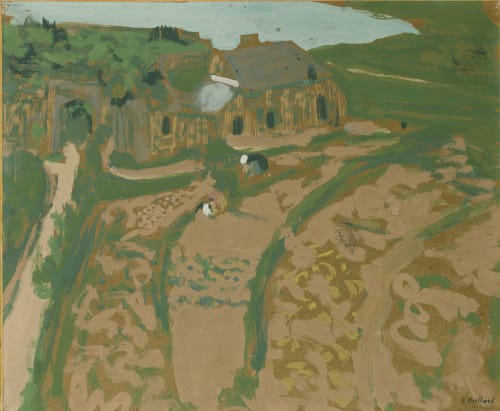Born in Cuiseaux, Saône-et-Loire, Vuillard was brought up in Paris in modest circumstances. He attended the Lycée Condorcet where his contemporaries included the musician Pierre Hermant and the writer Pierre Véber, as well as Maurice Denis and Ker-Xavier Roussel. In March 1886 Vuillard entered the Académie Julian where he was taught by Tony Robert-Fleury, and on his third attempt in July 1887 he passed the entrance examination to the Ecole des Beaux-Arts. In 1888 he was persuaded by Denis to become a member of the Nabis. He was influenced by Gauguin (through Sérusier), Degas, and Japanese art, producing flattened and patterned intimiste interiors in unusual compositions. With his seamstress mother (‘my muse’) he shared a small Paris flat, which was often filled with richly patterned materials; these elements form the tonally and chromatically close paintings which, with their subtle abstractions, express a fin de siècle claustrophobia and lay claim to a profound, painterly significance. He formed valuable friendships with the Hessels, Bernsteins, and Natansons of La Revue blanche and painted decorations for them, favouring distemper (a glue size and pigment mixture) on cardboard and canvas, a technique learned in the theatre. In the early years of the 20th century Vuillard began to show work at the Parisian gallery of the Bernheim-Jeune family and was later contracted to them. Lucy Hessel, wife of Jos Hessel, a partner in the firm, became a close friend, confidante and model, and Vuillard’s time was spent increasingly in the Hessels’ entourage, which included successful actors and playwrights as well as wealthy business people.
In 1912 Vuillard received his first commission for a public building, a series of decorations in Paris on theatrical themes to ornament the foyer of the Comédie des Champs-Elysées, a theatre within the new Théâtre des Champs-Elysées.
Portraiture became an increasingly dominant aspect of Vuillard’s work, and he found no shortage of sitters; many were fashionable members of the beau monde, others were intimate friends and professional associates. He effectively amalgamated the role of portrait painter with that of painter of interiors, portraying his models in domestic settings characteristic of them and often, in the process, extending the psychological penetration of the portrait. Whereas during his Nabi phase Vuillard had simplified and pared down his vision to a flattened pattern and had frequently attracted criticism for imprecision, from c. 1900 he treated space in a more three-dimensional way. Typically he set his model well back into the picture space and in some instances lavished almost as much attention on the familiar objects and minutiae that make up the interior setting as on the distinguishing features of his sitter.
Vuillard’s served as a war artist for part of World War I, sketching soldiers on the front line at Gérardmer. When hostilities ceased, Vuillard concentrated mainly on portraiture, still undertaking decorative commissions occasionally.
Between 1923 and 1937 Vuillard painted four important portraits of his closest artist friends: Roussel, Denis, Bonnard and Maillol, each of whom is shown at work in characteristic manner. A final major project was an enormous mural for the new League of Nations building in Geneva. He was elected to the Institut de France in 1937 and in 1938 a major retrospective, selected by the artist’s friend Claude Roger-Marx, was held at the Pavillon de Marsan in Paris.

